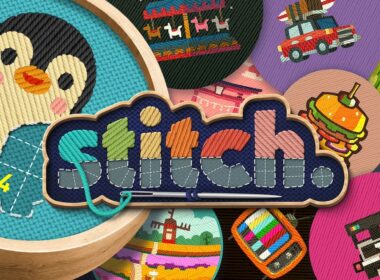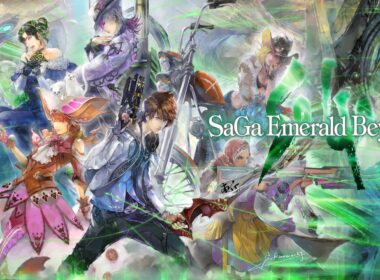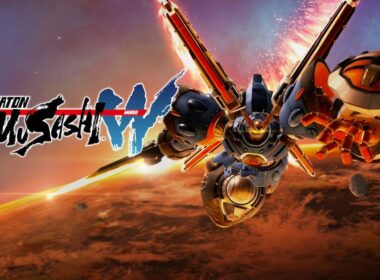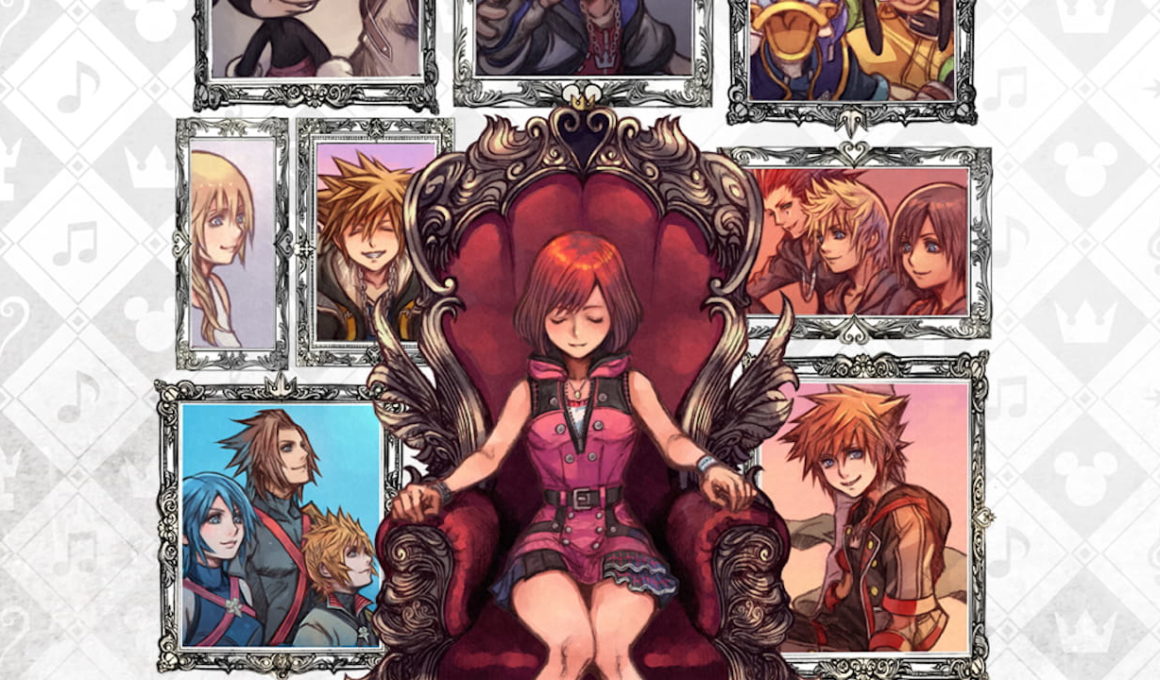In the 18 years that the Kingdom Hearts series has been going, the quality of the music has not only been constant, but has been consistently improving. Yoko Shinomura’s talent as a composer needs no further praise, she’s been one of the most well-renowned musicians at Square Enix for ages. The idea of a Kingdom Hearts rhythm game was something I never even knew I wanted, but when it was revealed I was instantly sold. Kingdom Hearts: Melody of Memory is a 3D rhythm game developed by the team that worked on the popular Theatrhythm Final Fantasy spin-off series. Framed as Kairi looking back through Sora’s memories after the events of Kingdom Hearts III, this game revisits the series with a musical twist.
Usually, the “side games” of the Kingdom Hearts series are equally story and gameplay heavy and might as well all be mainline games. Kingdom Hearts: Melody of Memory is a departure from tradition in this aspect, with the gameplay being the main focus and the story taking the backseat. Usually, this would be seen as a negative, and I’m sure some of my fellow game critics might have listed it as such, but this ended up being a positive for me. What story is given consists of narrated recaps of the entire series and around nearly thirty-minute epilogue of entirely new content. I won’t touch on this too much (because like with the game, this review will be focused on the gameplay) but I found this to work very well. It’s a fun way to wrap up the Dark Seeker Saga in a nice bow, and the new content matches up to what fans are used to with Nomura’s Wild Ride. I’ll say it upfront though, while this seems to be a good way for newcomers to catch up with the story without putting in the time investment, I would recommend against it. The story recaps feel designed for people who have already played the games, and there were numerous times where I laughed at how lost people would be if they just picked this up based on it looking like a fun rhythm game.
Having said that, wow is this a fun rhythm game. Explaining the “mechanics” of a rhythm game seems rather strange since the genre is pretty self-explanatory. Over-explaining them will do the genre no justice, but I will quickly assume you just shifted into our reality from a parallel dimension. At their core, rhythm games involve the player hitting a button in time to the beat of a song. Songs are meant to be played numerous times to encourage players to get the best possible score. They’re fun! I’ve seen many popular RPG series approach the idea of a rhythm game spin-off title, but few of them tend to break conventions. Kingdom Hearts: Melody of Memory understands that many members of the Kingdom Hearts fanbase are either younger or might not have played these kinds of games before, so the developers have simplified the core gameplay mechanics. Not only have they done this without dumbing down the difficulty curve, but the presentation of these mechanics is a lot more approachable and fits the Kingdom Hearts series perfectly.
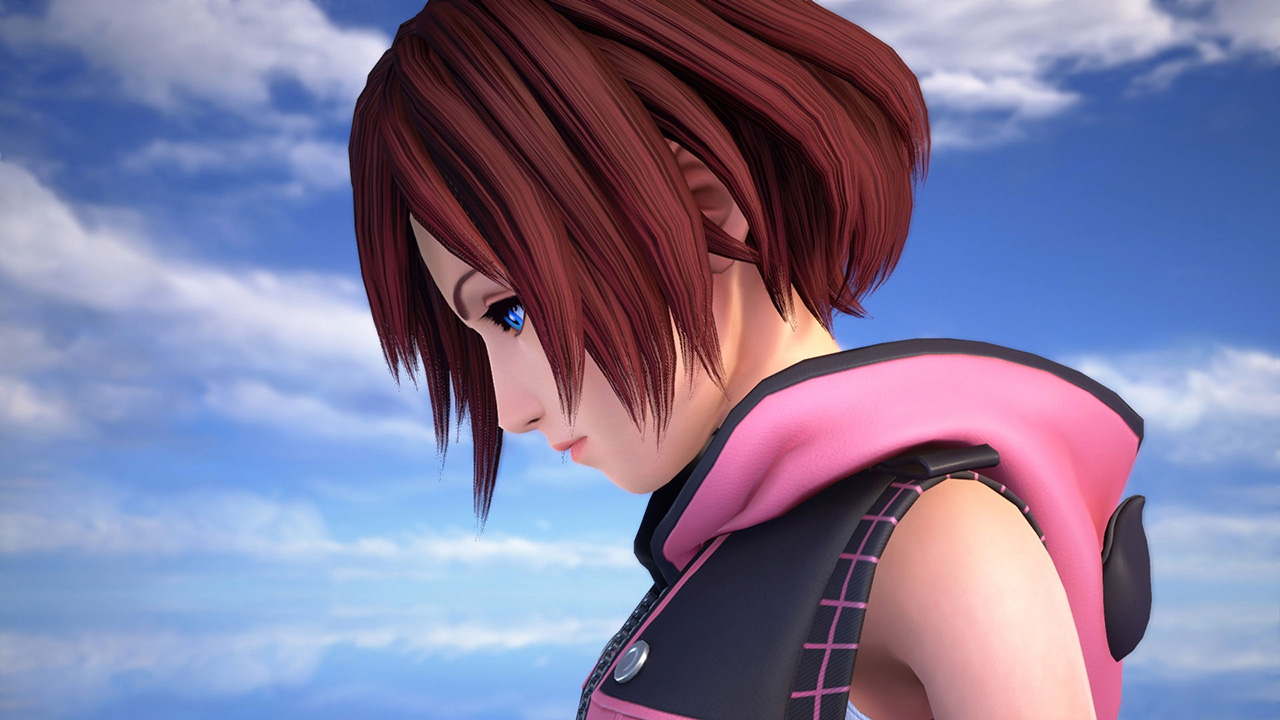
There are three different game modes in Kingdom Hearts: Melody of Memory: Field Battles, Boss Battles, and Memory Dives. Field Battles are going to be where you spend most of your playtime. These have you pick one of four popular Kingdom Hearts Trios – the original Kingdom Hearts crew, the Days Crew, the Birth By Sleep crew, and Dream Drop Riku with two Dream Eaters – to run through a track and attack enemies to the beat of a song. There are three buttons that can be used to attack, but unlike most games in the genre, specific buttons aren’t always required for specific notes. Depending on when you land this attack, you get a different “score” ranging from a Good to a rainbow-colored Excellent. If your character gets hit then it counts as a Miss which negatively impacts your score and decreases your health. Like with a normal Kingdom Hearts game, your health reaching zero will lead to a game over (in this case, failing the songs). Thankfully there are items you have the option to turn on if you find the game too difficult.
Unless you have to hit a double or triple note you can press any button to hit any note. Most of the time this meant I was able to just focus on tapping the A button to the beat of the song, using the L or R buttons only when I needed my main character to be occupied. What I love about this so much is that it allows inexperienced players to jump in but benefits the player base as a whole. You can customize your play experience however you see fit, and I loved that. There’s even a wonderful accessibility option to play every song with one button or turn on performer mode to add in more types of inputs for those wanting even more of a challenge. I would argue that the slower-paced songs are almost needed to be played on Proud to get any enjoyment out of them, because on Beginner or Standard the pace of them feels weird and not that fun. The game excels when you’re playing the faster-paced songs, which are a blast on any difficulty.
There are also different kinds of notes, like Ability Crystals that are activated with the X button and a jump button that can be used to dodge incoming projectiles and hit airborne enemies. Ability Crystals are mostly cosmetic and change depending on which team you are playing as, and if I were to offer a slight critique on this I feel like it’s lacking any depth. However, I recognize that adding stats or damage values to it would demolish the balance of the game and the rhythm. There was maybe a bit too much praise, so I hope that pace breaker woke up any nodding off readers. Jumping is also used for gliding if the button is held down, and these segments of the song require the player to control the active character with the left stick and follow a path of notes. Often the characters on the sides are given enemies or obstacles to attack while you glide, and the endorphins in my brain always flared up as I felt it fitting to time the left and right bumpers to their retrospective sides. The fun of all these mechanics come from how they’re combined as you master them, the design of the levels is expertly crafted. On paper, these are just other forms of input, which is standard for rhythm games to have, but the visual presentation of it kept me more engaged during each song than most of these games. The developers didn’t just lazily put Kingdom Hearts into this format, but they cleverly adapted the pre-established mechanics to allow fans to make the transition into the new gameplay style very well. They’ve even adapted the difficulty settings with the exception of Critical, but with how hard Proud is I can’t imagine how challenging that would be. If you’d like to get a better feel for how this works exactly, I recommend downloading the demo since it consists of only Field Battles.
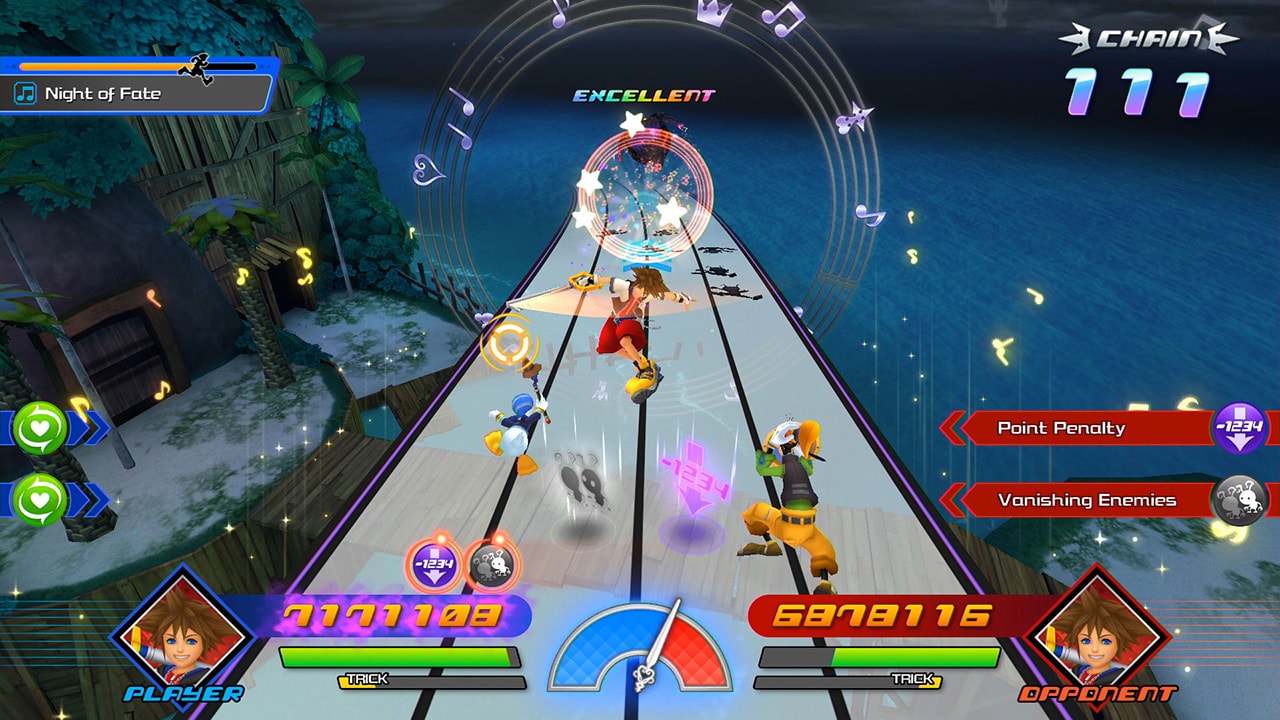
The other two game modes are very similar to each other, so I’ll have them share a paragraph. They also use the same kind of mechanics with just a different presentation style, which also saves us both time I would have wasted re-explaining everything. These are structured like more traditional rhythm games, with the player hitting specific buttons on a linear track. In Memory Dives you see your characters fly over an FMV cutscene montage. I liked these well enough, especially since they allow you to listen to the full versions of Simple and Clean and Sanctuary. When you do end up unlocking these, you also unlock Field Battle versions of the songs, which is a neat little touch. However, when things get intense, I found them to be distracting and made it difficult to hit notes properly. This is also the mode where you get to listen to Let it Go, so there’s that. Boss Battles have the same concept but involve seeing your chosen party fight one of the series’ iconic villains. How you perform in the song affects how your characters perform in battle, which decides if you will be able to dodge or block incoming attacks. Since you have to really just survive until the end of the song, it would be fair to call them shallow. However, at their worst, I found them a lot of fun and they’re a thrilling visual spectacle at their best. If I had to choose between which I liked more, I think I’d have to pick the Boss Battles. It’s unfortunate that the amount of Boss songs pales in comparison to the other two, with only a handful existing in the game.
This game is a lot more than just playing songs, offering a fun progression system and side modes that have kept me coming back again and again days after reaching the credits for the main story. I’m not even kidding, this review was heavily procrastinated because every time I went back to refresh my memory on mechanics I would lose hours to grinding away at completing challenges. The World Tour mode is the core of the game, which is how you progress through the story and unlock songs. In classic Kingdom Hearts fashion, you are given a world map and gummi ship, with the ability to visit popular worlds from the series. Each world has one or two songs, and each song has three challenges for each song. The challenges vary depending on the song, with some requiring you to get a certain chain combo or only missing a certain amount of notes. There are a lot more different kinds of challenges, but listing them would once again kill the pace of this review. When you clear a challenge, you gain a star. Gateways to a new set of stages are blocked behind obtaining a set amount of stars (which are color coded depending on which game the songs are based on). Thankfully the amount of stars required is always relatively low, so you aren’t forced to clear every song if you don’t want to. I found star collecting worked best in the post-game, where I went back to use them to unlock more songs. My favorite aspect of this has to be that the challenges are never “Clear X Song on the Hardest Difficulty while never once getting anything but a Perfect Score.” You have to put in some work to clear them all for each world, but they give you enough room for error to never make them feel tedious.
There are over 140 songs, and you can unlock them in the synthesis menu by combining them with other songs. Any rhythm game fan knows this is an insane amount of songs, and thankfully I can say that most of them are implemented very well. The song list is great overall, but I wish Kingdom Hearts III got a bit more love here. There are a very small number of songs from it here which is weird since it’s a “mainline” entry, but what’s most disappointing is that almost all of these are Memory Dives. A track selection is available to allow you to organize and sort songs depending on a few categories, which makes things easy for players who just want to pop in for a few minutes and relax with some Kingdom Hearts game.
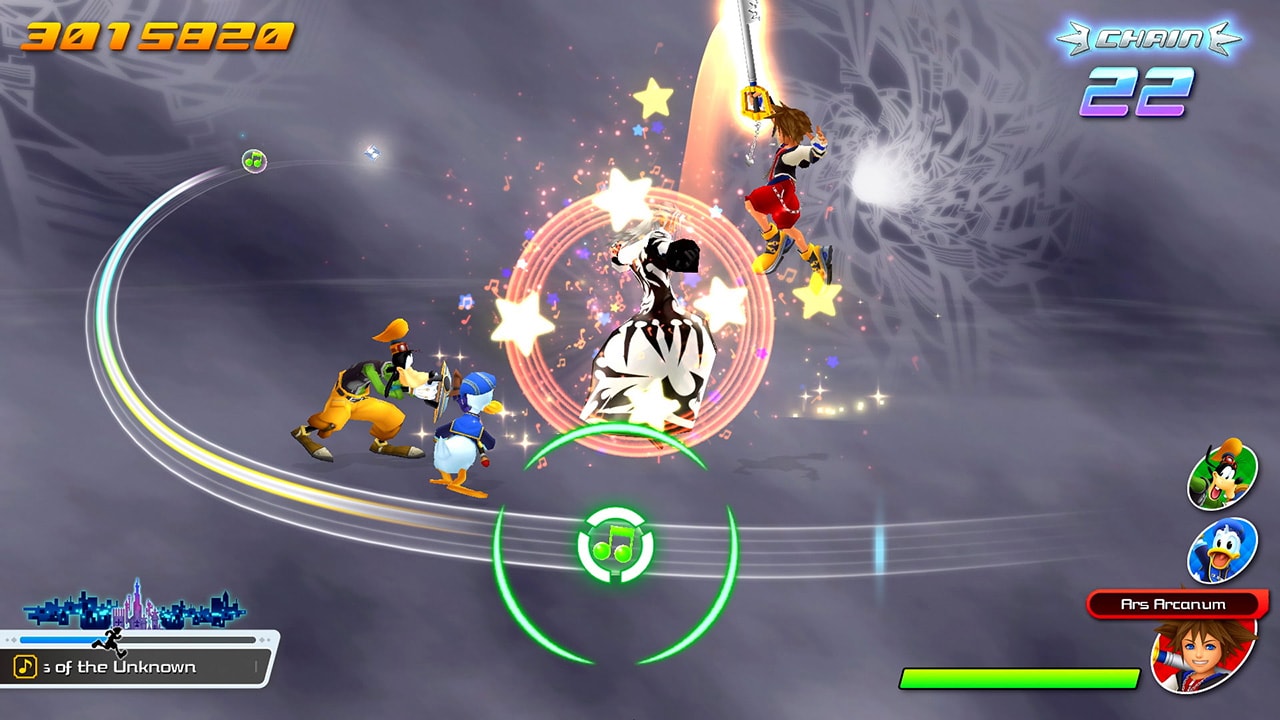
For those who don’t want to just relax, Co-Op and an online Versus mode are available. In co-op one person plays as Sora and one person plays as Riku. I didn’t have anyone to play this with in the full game, but I was able to see it in action during the demo and it’s a pretty fun time to have. Syncing up your dual notes with your friend and helping them out by successfully hitting ability crystals was consistently a chaotic form of entertainment. Full disclosure, I tried to play it by myself just now while writing this section of my review. I dual-wielded both Joy-Con like they were two keyblades in a parking lot, and clearing Don’t Think Twice with an A+ score made me feel a sense of immense pride. A pathetic, lonely sort of pride, but pride nonetheless. Make sure you play it with friends, kids. I played the Versus mode a single time, was destroyed, and haven’t really played it since. It’s not a mode for me, but I can see it being a lot of fun for those who are into that.
Not everything is perfect in this Prankster’s Paradise, however (sorry, but it’s a world in the game and if I had to spend time Googling how to make that pun work poorly you need to read it). I was surprised however to see that a lot of my gripes really just boil down to nitpicks with the Nintendo Switch version or the game not checking off the boxes of my personal wishlist. The Switch version is mostly very solid, with a great performance and no real hit to the game’s visuals. However a lot of my friends who had also played this version noticed that the button timing felt off at random intervals. This led to a lot of my few hours with the game to feel very clunky, and this review was initially going to be a lot more negative than it ended up being. Then someone told me to go into the configuration menu and set the “BGM Timing” to +1. I have no idea what exactly it did, as I’m more of a casual enthusiast for the genre, but I noticed an immediate improvement. If the game’s default timing is bothering you, make sure to go and do this.
There are a couple small details I wish the developers had added that I feel would have made for a better package overall. The party customization and leveling system is very nice, but it would have been nice if you could have made your own party. It would have been great if Sora’s outfit could change depending on what game the song you are playing is from, or just let you change it to whatever you wish. I’m neutral on Sora’s original outfit because I feel like every other outfit of his in the series is much better. Characters like Riku and Roxas also have multiple outfits, and it would have been a great touch if you unlocked the ability to customize them after you clear the main story. This seems like it could be unfeasible, but if the player uses an item to summon Mickey as a partner his outfit changes depending on which party he’s in. It would have been a really cool touch to be able to play Team 3D with Dream Drop Sora if you wanted, and it’s such a shame that the only way you get to see Sora and Riku work together is in Co-Op. These critiques are all cosmetic, and because they don’t negatively impact the experience too much I’m not going to consider them as too damning.
Kingdom Hearts: Melody of Memory was one of the rare instances where my experience with a game I’m reviewing only improved upon reflection. When you get engrossed in a rhythm game they always end up feeling very addicting, but I don’t think I’ve ever been this invested in this genre before. It’s not perfect but it perfectly captures the spirit of Kingdom Hearts, which is all I ever really wanted from it in the first place. There were a couple of spots that left me slightly disappointed, but I can’t deny just how much I enjoyed this as a long time fan of this series. This is a love letter to fans, offering a lot of replayability and exciting gameplay for any willing to give it an open-minded chance. The story seems rather minor for fans who are invested, but what is there has a lot of very exciting nods to the future of the series that I would hate to ruin for you if you haven’t finished it yet. The Switch is a very perfect system for this game in my opinion once you customize the timing to your liking, with the portable nature of the system meshing great with the gameplay style. It ties a very charming bow on 18 years of games, and even with its faults has been something I haven’t been able to stop thinking about since I started playing. Honestly, as soon as I finish typing this sentence I’m going right back to playing more.
Version Tested: Nintendo Switch
Review copy provided by Square Enix

